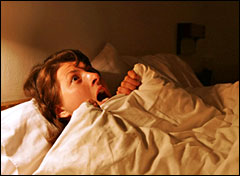Dear Umbra,
I desperately need your help. My house has become infested with bedbugs! I’m trying to find an environmentally friendly way to get rid of them. I’ve tried a thorough cleaning and tried using diatomaceous earth (fossil shell flour) to no avail. The local exterminator is looking more and more appealing. Please stop me before I do something rash like resorting to him and the nasty chemicals he’ll be using.
Ofer
Pasadena, Calif.
Dearest Ofer,
Yipes. Would it help to know that you are not alone, or is that cold comfort? Can I distract you by offering scintillating scientific information about this blood-sucking, night-feeding parasite, Cimex lectularius? For example, the female bedbug possesses a secondary copulatory aperture — a notch, or invagination, in her body wall — known as the Ribaga’s organ. During mating, the male actually pierces her exoskeleton with a dagger-like, spermatozoa-carrying organ in a process known as traumatic insemination.

Don’t let the bedbugs bite.
But back to the reality at hand: Bedbugs were largely eliminated from the U.S. during the DDT years but remained fairly common overseas. Now they’re reappearing with a vengeance, showing up in apartment buildings, hotels, dorms, and other places across the country. They are quite wee (the adults are described as lentil-sized) and very flat. They’re hard to spot, fit easily inside tiny crevices all about your home, and happily travel between apartments through wiring holes — or as stowaways in luggage, clothing, bedding, and such. Their enticingly named “blood meals” can result in very itchy and persistent red welts. Bedbugs can go a year without eating, so starvation by abandonment is not an option.
The upshot of all this is: The exterminator is likely your best hope. Let me clearly state that we’re all environmentalists here, and we wish to avoid using pesticides. But we also have a social responsibility to the greater Public Health, and this responsibility requires us to kill those bedbugs dead and spare our neighbors, coworkers, fellow bus riders, and world-at-large from the resurgent scourge. The little critters are so wily — and so resistant to and/or hidden from steam, vacuuming, cleaning, squishing, and other methods — that a professional is often the only one with enough training, patience, and skill sets to get rid of them. The most helpful information I found about managing an infestation was from the Harvard School of Public Health and from the University of Kentucky. Read these documents if you suspect bedbugs are biting you and yours; I cannot do justice to the detailed instructions here.
If you are a tenant with bedbugs, call your landlord immediately and work with him/her to make an eradication plan. As you already know, Ofer, it’s also important to clean and declutter your dwelling, tightly bag up all your garments and bedding, and vacuum every crevice of the house (don’t forget to discard the vacuum contents within a tightly sealed bag).
These steps should be taken in preparation for having a licensed, recommended professional with a thorough Integrated Pest Management plan come to debug your home. The responsible pest controller will not put pesticides on your bed, and will use a combination of physical controls (e.g., more vacuuming), and pesticides to fix you up like new. Hopefully.
Be extremely cautious with your infested possessions, including those that you need to throw out. Keep everything isolated, encased in plastic — or even defaced, to make sure a dumpster diver doesn’t take it home (again, see Harvard’s detailed instructions).
Don’t let infested furniture fall into the hands of an innocent thrift store shopper, or leave them out on the curb as freebies. That would be cruel and unusual charity.
Unfortunately,
Umbra


